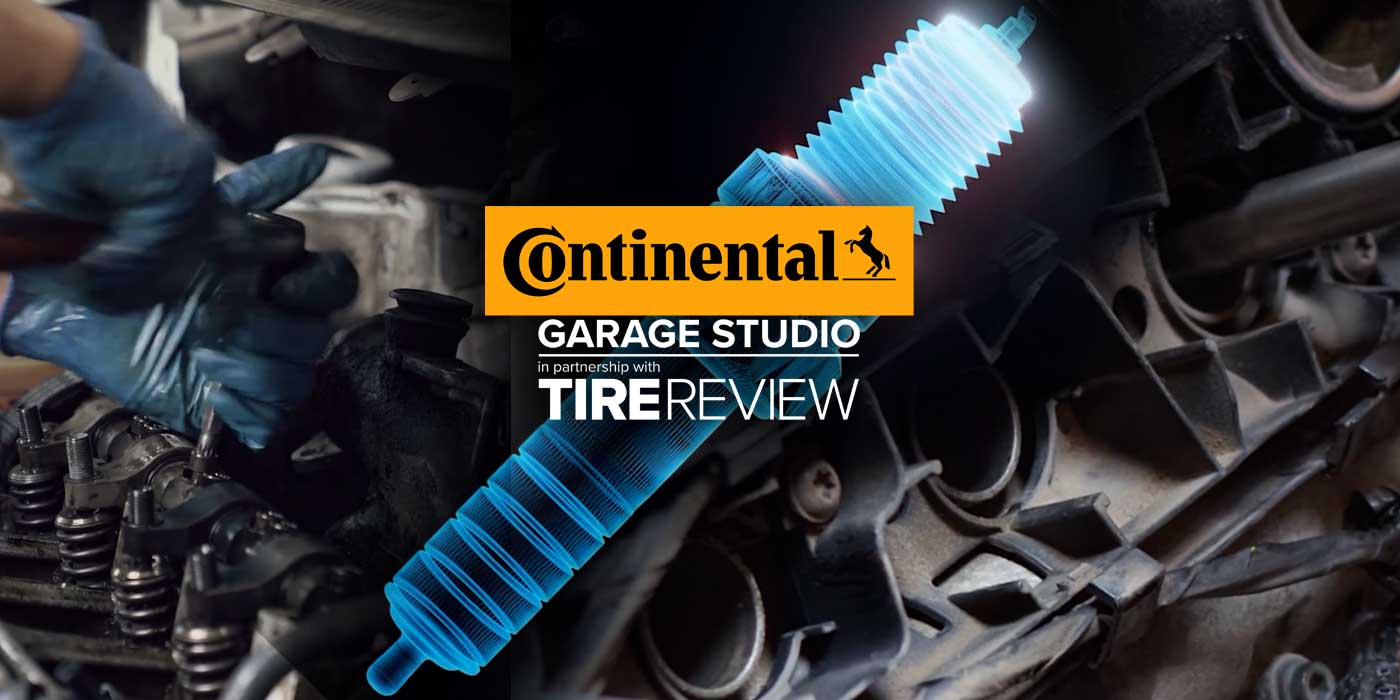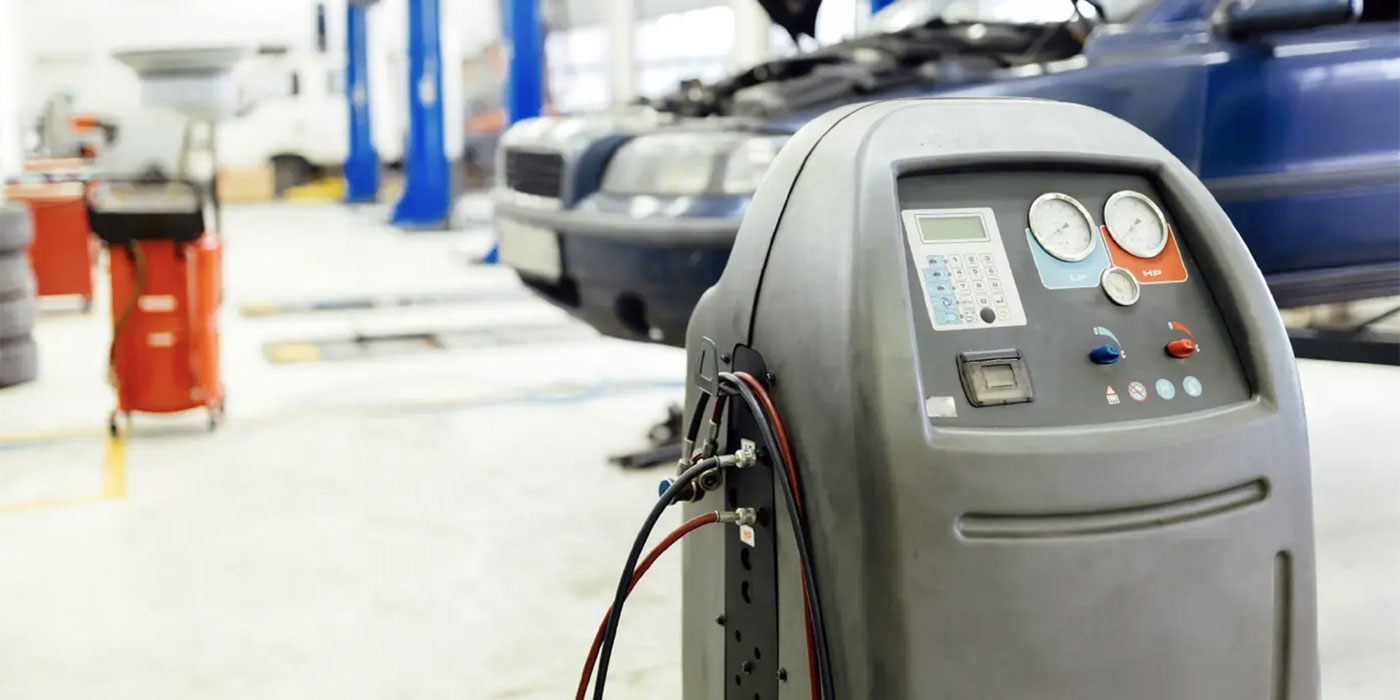Nearly every tire dealer offers vehicle service – whether it is basic maintenance or complete repairs. Service is a major revenue stream for tire dealers, especially in today’s economy where drivers want/need to “get another year” out of their vehicles.
So it’s not surprising that the typical tire dealer will see well more than 50% of his/her annual revenue come from service work; some dealers easily top 80%. The cost to participate – ongoing training, equipment, parts and supplies – is high, but dealers are responding and are taking advantage of the opportunity to shore up their service side.
To help add to their education regime, Tire Review has compiled an extensive collection of key questions often asked by service technicians of all skill levels, and responses from our cadre of auto service experts.
Visit tirereview.com to see a more extensive collection of vehicle service questions and answers, and email [email protected] with your comments about this feature!
SERVICE FORUM: BATTERIES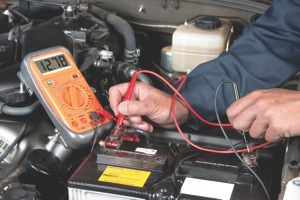
Q. How can you tell if a battery needs to be replaced?
A. There are several ways to determine if a battery is "good" or "bad." A battery is “bad” and needs to be replaced if: a) it is fully discharged (no voltage at the terminals) and it won’t accept or hold a charge; b) it takes a charge but never recovers to full voltage; or c) it accepts and holds a charge, but fails to maintain a certain voltage when a load is placed on the battery (or it fails to delivery its normal current).
Batteries are tested for two things: state of charge (a base voltage measurement that shows if the battery is low or fully charged), and capacity (a load or conductance test that checks the condition of the plates inside the battery).
Connecting a voltmeter to the battery’s positive and negative terminals (key off and all lights and accessories off) will reveal the charge level of the battery. A reading of 12.66 volts indicates a fully charged battery. If the reading is 12.45 volts or less, the battery is low and needs to be recharged.
Some batteries have a built-in charge indicator; a green dot tells you the battery is 75% or more charged. A dark indicator (no dot visible), means the cell is low and the battery needs to be recharged. A yellow or clear indicator tells you the electrolyte level inside the cell is low and the battery needs water. If the battery has a sealed top and water cannot be added to the cells, the battery must be replaced.
A load test or conductance test will tell you if the battery is still usable. The load test is done by applying a current load on the battery (one-half of its cold cranking amp or CCA rating) with a load tester for 15 seconds. A good battery that is at least 75 percent charged should not drop below 9.6 volts.
A conductance battery tester is faster and easier, and can be performed even if the battery is run down. The conductance tester pulses an alternating frequency signal through the battery to reveal the battery’s condition. If it fails the test, your customer needs a new battery.
Q. How long should a car battery last?
A. All lead-acid car batteries have a limited service life, which is typically four to five years with wet cell batteries, and a couple of years longer with absorbent glass mat (AGM) batteries. How long a battery lasts depends on battery construction (conventional wet cell or AGM, and the durability of the cell plates and connectors), the operating conditions to which the battery is subjected (heat, cold, vibration, frequency of use), the number of discharge/charge cycles it has experienced, and the condition and performance of the vehicle’s charging system.
For maximum life, auto batteries must be maintained at or near full charge throughout their life. Auto batteries don’t recover well if they are allowed to become fully discharged. This can occur if there is a problem with the vehicle’s charging system, leaving the lights on after turning the engine off, or not driving the vehicle often enough or far enough to keep the battery at full charge. The electronics in today’s cars continue to draw current from the battery when the key is off. Though many models go into "sleep mode" to conserve power, there can still be a steady drain of power that will eventually run the battery down if the car isn’t driven often enough or long enough to fully recharge the battery.
The key-off power drain can be fairly high in many late model vehicles (80 milliamps to several hundred milliamps), which means it can take up to 20 minutes of driving every few days to maintain the battery at full charge.
Heat is also hard on batteries. High ambient temperatures and high underhood temperatures increase the evaporation of electrolyte from a wet cell lead-acid car battery. Average battery life may be as short as three years in a hot climate because of this.
Increased evaporation and even plate damage can also occur from overcharging. This may be the result of a defective charging system in the vehicle, or overcharging a low battery with an unregulated battery charger that does not taper off the charging current as the battery comes back up to full charge.
Sub-zero temperatures can also cause the liquid electrolyte inside a battery to freeze if the battery is discharged (which can damage cell plates). Cold temperatures reduce the chemical reactivity inside a battery, reducing its ability to produce current. But the battery will recover as it warms up.
Battery life can also be cut short by excessive vibration. Constant shaking and pounding from driving on rough roads may cause internal connections or cell plates to crack and fail.
SERVICE FORUM: BEARINGS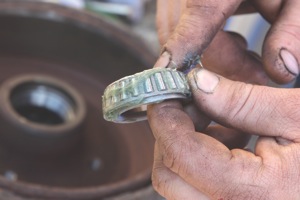
Q. How can you tell if a wheel bearing is failing?
A. Noise is the most common symptom, usually a cyclic chirping, squealing or growling noise that changes in proportion to vehicle speed. The sound may disappear at some speeds or only occur at certain speeds. The noise may get worse when turning, or it may disappear momentarily.
Looseness or roughness in the bearings are another symptom. Any play or roughness that can be felt when rotating a tire by hand may indicate trouble. If the bearings are the adjustable type, cleaning, repacking and readjusting the bearings may solve the problem. But if the vehicle has sealed wheel bearings, looseness or roughness, it’s time to replace the bearings.
You should warn customers not to postpone replacing a failing wheel bearing. If a front hub bearing fails, it may cause the wheel to lock up or come loose, either of which can create a potentially dangerous situation if it occurs while driving at highway speeds. The same thing can happen with axle bearings on rear-wheel drive and four-wheel drive cars and trucks.
To check wheel-bearing play, raise the vehicle so the wheel is off the ground, then grab tire at the 12 and 6 o’clock positions and rock the tire back and forth. As a rule, you should not feel any play or looseness if the vehicle has sealed wheel bearings. On older vehicles with adjustable wheel bearings, a little play is normal but a lot of play is not. Refer to the vehicle’s service specifications for the maximum amount of acceptable play.
Wheel bearing play can be measured with a dial indicator by placing the dial indicator against the hub and rocking the wheel in and out by hand. As a rule, you should see no more than .005 inches of play if the bearings are good.
Q. What can cause a wheel bearing to fail prematurely?
A. Wheel bearings are engineered to last the life of the vehicle, which typically means 150,000 or more miles of normal driving without a failure. Many vehicles go to the salvage yard with their original wheel bearings intact. But others have bearing problems long before that.
Dirt and moisture are common causes of wheel bearing failure. Bearings are sealed to keep grease in and to keep moisture and dirt out. If the seals are worn or do not fit tightly enough, the seal may leak allow grease to escape and/or outside contaminants to enter the bearing. Either way, it’s bad news for the bearing.
Loss of lubrication can cause the bearings to run hot and experience micro-welding, pitting and galling. Moisture will promote rust and eat away at the polished bearing surfaces, and it will contaminate the grease inside the joint reducing its ability to maintain a protective film between the moving parts. As little as 1% water in the grease can be enough to shorten the life of the bearing. Dirt is abrasive, and that’s no good for the bearings either.
Driving a vehicle through hub-deep water can sometimes force water past the seals into a wheel bearing. The seals are designed to withstand normal road splash, not the pressures that may occur when a hub is submerged under water for any length of time. The bearings won’t fail immediately, but any water that gets inside will slowly corrode and eventually ruin the bearings (or ABS sensor if the bearing assembly has an internal ABS sensor).
A good example of this are the problems boaters frequently have with the wheel bearings on their boat trailers. Backing the trailer into the water to load or unload a boat submerges the bearings. If the bearings are not cleaned and repacked with water-repellant grease every season, they won’t last very long.
There’s no way to clean and repack sealed wheel bearing units or hub assemblies, so the best preventative is to avoid driving through water that’s over the hubs.
Excessive loading also can pound a set of wheel bearings to death. Wheel bearings (particular ones with tapered roller bearings inside) are pretty stout and can take a lot of punishment. However, hard cornering and driving on extremely rough roads for prolonged periods of time can produce brinelling (dimples or bumps) on the bearing surfaces. Eventually, this may result in fatigue cracking and failure.
Stray electric currents that pass through a wheel bearing can also cause arcing and pitting that cause bearings to fail. This may occur if an engine, chassis or body ground strap is broken, loose or corroded. Electrical currents will follow quite unusual paths to find their way back to the battery, and that may involve passing through the wheel bearing. Static discharges that occur when the tires are rolling on the ground can also and compound the problem.
Installation errors are another cause of premature bearing failure. The most common mistakes here are not using the proper driver to install a new bearing, beating on the bearing to get it to fit; over-torquing the axle nut; not using the proper type of amount of wheel bearing grease when installing a serviceable wheel bearing; and not setting the proper preload on adjustable bearings. Contributing factors that may cause a bearing to fail are a hub or knuckle bore that is out of round or badly corroded.
Q. Do wheel bearings require maintenance?
A. Wheel bearing cartridges and hub assemblies on late model vehicles do not require any maintenance. They are sealed for life and cannot be lubricated.
However, many older vehicles on the road still require wheel bearing maintenance. On these applications, the wheel bearings are not sealed and do require periodic inspection, cleaning and repacking with grease. The recommended service interval is typically every 30,000 to 50,000 miles (or more frequently if the vehicle is driven off-road or through hub deep water).
Wheel bearings should also be inspected and lubricated when the brakes are serviced, or if a bearing problem is suspected (noise, roughness or looseness).
Serviceable wheel bearings should be disassembled, cleaned and allowed to air dry. Roller bearings should NOT be force-dried with shop as spinning the bearings with no lubrication risks damaging them. The bearings should then be visually inspected for hairline cracks, flat spots, dimples, flaking, wear or damage. If a bearing race, roller or cage is bad, the bearing must be replaced.
Note: The entire wheel bearing (inner and outer races, and the ball or roller bearings and cage) must be replaced as a complete assembly. Parts are precision matched and should never be mixed with old parts or parts from another bearing.
Wheel bearings should only be lubricated with high temperature bearing grease, never ordinary chassis grease. A #2 NLGI lithium-based grease or a synthetic wheel bearing grease should be used. The hub cavity needs to be about 2/3 full to leave some air space for thermal expansion. Also, the old grease seals in the hub should be discarded and replaced with new ones.
After the bearings have been installed, bearing end-play must be adjusted to specifications by tightening and then backing off slightly the spindle nut. Most older cars and trucks allow a small amount of end-play, but some require a slight preload. The grease cap must also fit tightly to keep water and contaminants out of the hub.
Q. What’s the difference between tapered roller bearings and ball bearings?
A. Tapered bearings have cylindrical rollers between the inner and outer race. The rollers are held in place by a steel or phenolic cage. The rollers are larger on one end than the other and rotate in a cone-shaped path. This allows the bearing to handle sideways loads and well as vertical loads. The larger surface area of tapered bearings allows them to support greater loads than ball bearings, which is why tapered bearings are often used in larger, heavier vehicles. Tapered roller bearings are also used in most older vehicles with serviceable wheel bearings.
Double row ball bearings have round steel balls between the inner and outer race. Like roller bearings, the balls are held in place by a steel cage. Ball bearings are less expensive to manufacture than tapered bearings, and produce less friction which helps improve fuel economy. This type of wheel bearing is often used the sealed hub assemblies on many late model cars. But ball bearing wheel bearings have a smaller surface contact area than roller bearings and can’t handle severe side loads as well as tapered bearings. Consequently, the wheel bearings may not stand up well to the forces that are generated by hard cornering in applications such as police cars or performance cars that are driven aggressively.
Q. Can wheel bearings be damaged during installation?
A. Yes. Installer error can ruin a new set of bearings. On front-wheel drive applications where a sealed bearing cartridge has to be driven or pressed into a knuckle with a hammer or hydraulic press, the proper driver tool must be used so the force is directed against the outer rim of the bearing housing.
The bearing must also be carefully positioned so that it goes in straight. Pounding or pressing on the inner race or cocking the bearing during installation may damage or misalign the bearings.
Some front-wheel drive wheel bearings also require special installation procedures, such as using shims or spacers for proper preload and positioning. An impact wrench should NEVER be used to tighten the hub nut. The hub nut must be torqued to the specified torque using an accurate torque wrench.
On applications where a sealed hub assembly is bolted to the knuckle or axle, a torque wrench should also be used on the mounting bolts to assure even loading and fastener retention.
SERVICE FORUM: BELTS & HOSES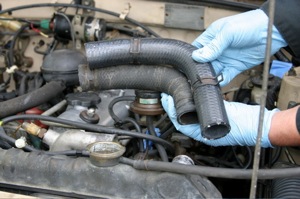
Q. If a serpentine belt is squealing should it be replaced?
A. It depends on the condition of the belt – worn or contaminated with oil or coolant – and belt tension. A worn or glazed serpentine belt can be noisy as can a belt that has been contaminated with motor oil, grease or coolant. But even a relatively new belt in good condition can slip and squeal if the automatic tensioner is weak or the belt is not tensioned properly.
An automatic belt tensioner uses spring tension; a stiff coil spring inside pushes the tensioner arm and pulley outward to keep the belt tight. Over time the spring may weaken or break. The pivot arm may also stick or bind as a result of rust and corrosion, preventing the tensioner from exerting adequate pressure against the belt.
Symptoms that would indicate a need for a new belt tensioner include excessive belt flutter when the engine is revved, noise from the tensioner pulley bearings, visible wobble or looseness in the tensioner pulley, binding or dragging in the pulley bearings (the pulley should rotate freely and quietly), or belt squeal immediately after engine start up, when turning or turning on the A/C.
Sometimes belt noise may be the result of someone having installed a replacement belt that is the wrong length. If a belt is too long, the tensioner may not have enough travel to keep the belt tight. Markings on the base and arm of an automatic tensioner indicate the tensioner’s minimum and maximum range of travel. The indicator should usually be about half way between the minimum and maximum marks. If the indicator is at or near the maximum mark, it means the belt is worn and needs to be replaced.
Q. How do you determine belt wear on a serpentine belt?
A. Most late model serpentine belts are made of EPDM rubber, which allows belts to last upwards of 100,000 miles. EPDM rubber belts can still look like new even at high mileage, and don’t crack like older neoprene belts so there are fewer telltale clues that a belt may be nearing the end of its service life.
The best way to gauge belt wear is literally with a special gauge designed for this purpose. Several belt suppliers have inexpensive plastic belt wear gauges that can reveal the true condition of a serpentine belt. The gauge fits into the grooves on the underside of the belt. If the gauge is flush with the tops of the grooves, the belt is worn and needs to be replaced.
Belts made of rubber or other synthetic rubbers should be replaced if they are cracked (more than four cracks per inch), frayed or have chunks of rubber missing. Belts should also be replaced if they have been contaminated with oil, grease or coolant.
Q. What could cause the premature failure of radiator or heater hose?
A. Heat and ozone accelerate the normal aging process that cause natural and synthetic rubber hoses to lose their elasticity and become hard and brittle. EPDM hoses are more durable in this respect, but they too can deteriorate after many years of service.
If a coolant hose fails at unusually low mileage, it may signal something unusual is going on inside the cooling system, such as electrolysis corrosion. Contaminants in the coolant such as salts or minerals, or depleted corrosion inhibitors in the coolant can allow electric currents to use the coolant as a conductive path. This can accelerate internal corrosion of vulnerable metal parts (heater core, radiator and other parts) as well as the hoses. Electrolysis can eat pits and lesions into the inside lining, weakening the hose and eventually eating all the way through.
If a low mileage hose has failed, it should be cut open and inspected to see if the inside has been attacked by electrolytic corrosion. If it has, the cooling system needs to be cleaned and flushed, and refilled with fresh 50/50 premixed antifreeze to avoid the possibility of recontamination with softened water or tap water. If a customer is refilling with full strength antifreeze, they should mix it in equal parts with distilled water, never ordinary tap water.
Also, the vehicle’s electrical system needs to be checked for missing, loose or broken engine-to-chassis ground straps. If ground straps are not making a good electrical connection, electrical currents between the battery, charging system and other electrical circuits may use the coolant as a path to ground.
New radiator and heater hoses should always be recommended for any customer who is replacing a water pump, thermostat, heater core or radiator. By the time these other cooling system parts fail, the hoses likely need to be replaced too. New clamps are also recommended.
SERVICE FORUM: BRAKES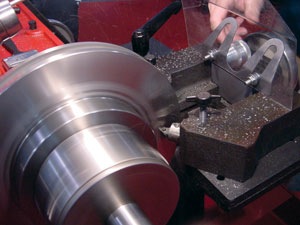
Q. Are there any standards for comparing friction materials?
A. Yes. One such rating method is the SAE J661 and J866A Brake Lining Quality Control Test, also called a "chase" test. A one-inch square of friction material is placed in a special machine that measures the material’s coefficient of friction over a range of temperatures. From this, the low- and high-temperature friction ratings for the material are determined and printed as a two-letter edge code on the brake linings.
The edge code letters for most passenger car and light truck linings are some combination of E and F, while G and H are found primarily on racing pads. The coefficient of friction range for E is 0.25 to 0.35 (least aggressive), F is 0.35 to 0.45, G is 0.45 to 0.55, and H is 0.55 to 0.65 (most aggressive).
Edge codes tell you something about how a particular set of brake pads feel and behave as they get hot, but it tells you nothing about how quickly they recover from fade, how they wear or how much noise or dust they make.
As a rule, the better the friction material, the more consistent will its friction characteristics be under different temperatures and pressures. A friction material rated FE will provide good braking when cold, but may fade when it gets hot. A material rated EF may take a little more pedal effort when cold, but will experience less fade as it gets hot. Friction materials rated FF and higher are often recommended for performance applications.
Brake dynamometer tests such as SAE J1652 can also be used to verify the friction characteristics of a given brake lining material. The dyno uses an actual brake assembly (drum or disc) to stop a large rotating flywheel. The mass of the flywheel simulates the momentum of a vehicle coming to rest.
Other brake dyno tests such as SAE J2430 test the performance of the front and rear brakes at the same time. Similar tests include the dual-dyno brake test called "BEEP" (Braking Effectiveness Evaluation Procedure) and "D3EA". These tests use a dual brake dyno setup to simulate the interaction of the front and rear brakes when the brakes are applied. The test generates a data map that can be plotted and compared against the OEM brake linings or other aftermarket linings for comparison purposes. Such tests help assure that replacement linings feel and perform similar to the OEM linings.
Q. Can you mix different kinds of friction materials on the same wheel?
A. Yes. Some OE and aftermarket brake suppliers are now using different types of friction materials for the inner and outer brake pads on the same wheel. By doing this they can take advantage of the different performance characteristics of different friction materials to improve overall brake performance and customer satisfaction.
Semi-metallic friction materials, for example, can handle high braking temperatures better than nonasbestos organic (NAO) and ceramic compounds and have good fade resistance. But semi-metallic pads may require more brake pressure when the brakes are cold, and increase rotor wear and noise due to their harder consistency.
Ceramic friction materials are typically quieter than semi-metallic linings, resist wear better than most NAO friction materials, and produce little visible brake dust. Many ceramic compounds are also rotor friendly and reduce rotor wear. But ceramics can’t handle as much heat as semi-metallics can under hard braking conditions.
Back in the 1970s, GM had some passenger car disc brake applications that used semi-metallic pads on the inside and asbestos pads on the outside. When asbestos was phased out and nonasbestos friction materials become commonplace, this practice was discontinued only to reappear again recently as a way of optimizing brake performance by combining different friction materials.
Ceramic friction materials have been used as original equipment on a majority of cars for many years, but recently GM and some other carmakers have gone back to harder semi-metallic linings on some applications to extend pad life and reduce stopping distances. The trade-off has been reduced rotor life in some cases.
One way around this has been to mix different friction materials on the same wheel, which is what some OE and aftermarket brake suppliers are now doing. A semi-metallic pad or friction material with a slightly higher coefficient of friction may be used on the inside of the rotor with a softer and less aggressive ceramic or non-asbestos organic pad on the outside.
Under no circumstances should different types of friction materials be used on opposite sides of a vehicle (same axle). Any significant difference in friction coefficients side-to-side (right to left or vice versa) can cause uneven braking and a brake pull. Since brake pads are normally replaced in matched axle sets (both front, both rear or all four wheels), this is usually not a concern. But it can be if a customer is replacing only the brake pads on one wheel because the pads were contaminated by brake fluid from a leaky caliper.
The same issue can arise if a customer is replacing a leaky or frozen caliper with a loaded caliper that comes preassembled with new pads. The new pads in the loaded caliper should match the friction characteristics of the old pads on the opposite wheel, otherwise the pads on both sides need to be changed to keep braking effort equal.
Q. What’s the best way to break in new brake pads?
A. Avoid heavy braking or panic stops for the first couple of hundred miles. Normal driving will usually seat in most brake pads just fine, provided the rotors are clean, relatively smooth (no excessive scoring or grooving) and flat (no warpage or pedal pulsations). If the rotors are not in good condition, they need to be resurfaced or replaced.
Many brake experts recommend breaking in new brake pads with a 30-30-30 procedure: 30 gradual stops from 30 mph with 30 seconds in between each stop for the brakes to cool. This procedure will prevent the pads from getting too hot until the resins have fully cured.
The worst thing anybody can do is a hard panic stop with a new set of unseated brake pads. This may glaze the brakes, which can result in brake squeal and reduced braking effectiveness.
Q. Should rotors be replaced when new pads are installed?
A. It depends on the condition and thickness of the rotors. The rate at which rotors wear depends on a lot of variables: the type of brake pads on the vehicle, the metallurgy (hardness and quality) of the castings, how efficiently the rotors cool themselves, the type of driving the vehicle is subjected to, the braking style of the driver (aggressive or easy), and exposure to moisture and road salt.
Rotors must be replaced if they are cracked, worn out or severely corroded.
The thickness of the rotors determines their useful service life. OE rotors on many late model vehicles are somewhat thinner to save weight and cost. Thinner rotors obviously don’t have the service life of thicker, heavier rotors, and may not have enough metal left in them to be resurfaced by the time the pads need to be replaced. Rotors must be replaced if they are worn down to the minimum thickness or discard specification or cannot be resurfaced without exceeding these dimensions.
The minimum thickness specification is critical. As a rotor wears and becomes thinner, it has less mass, reducing its ability to absorb and dissipate heat. It also reduces the strength of the rotor, increasing the risk of cracking or even breaking (rotor failure). Thickness of rotors should always be measured with an accurate brake caliper every time the brakes are serviced. If a rotor is worn down to the minimum thickness specification, or cannot be resurfaced without exceeding the discard dimension, it must be replaced. In some states, this is the law.
Replacing one worn out rotor usually means replacing both rotors on the vehicle, since they usually experience the same amount of wear. Many brake experts recommend replacing both rotors at the same time (even if one is still "good") to maintain even braking side-to-side. A significant difference in rotor thickness may cause the brakes to pull toward one side.
Q. Will resurfacing rotors eliminate a brake pedal pulsation?
A. Brake pedal pulsation is caused by thickness variations between the faces of the rotor. As the rotor turns around, any variation in thickness of more than about .001 inches may be felt when the brakes are applied. Resurfacing the rotors to make both faces flat and parallel will temporarily solve the problem, but it may be only a temporarily fix.
With a pedal pulsation issue, most experts recommend replacing the rotors. The thickness variation that causes pulsation is often the result of hard spots in the rotor that extend deep into the metal. Resurfacing only shaves off the top of the hard spots. Eventually, the hard spots return – sometimes within a few thousand miles after resurfacing.
The hard spots and/or uneven wear may be the result of casting or metallurgical imperfections in the rotor, but can also result from distortions in the rotor hub caused by uneven tightening and loading of the lug nuts. Lug nuts should always be final tightened with a torque wrench, never an impact wrench or by hand.
Q. How much rotor runout is too much?
A. Runout specifications vary from one vehicle to another, with some being more sensitive to rotor runout. Runout is measured by placing a dial indicator gauge against the face of the rotor and then rotating the rotor one full turn. A rotor that is running true should have .002 inches or less of lateral (sideways) runout. More than this may cause problems on some vehicles.
Excessive runout may be due to a stack up of manufacturing tolerances in the hub or rotor, inaccurate rotor machining, an accumulation of dirt or rust between the rotor hat and hub, or uneven loading due to uneven lug nut torque.
Runout can sometimes be reduced by reindexing the rotor position on th










